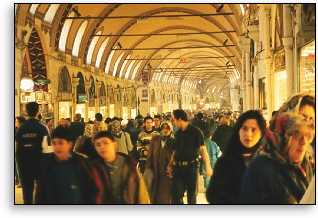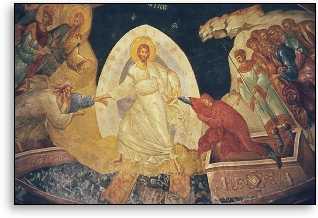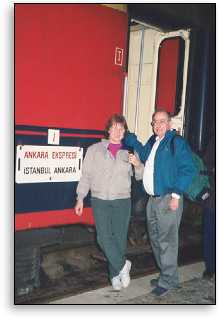Istanbul: Covered Bazaar, Chora Church, Beyoglu district, Bosphorus cruise
Western Turkey - Personal Journal
Day 6
- Monday, 6 April 1998
This was our last day in Istanbul so we took our luggage to the lobby by 8:15, where the bus was waiting to take us to the covered bazaar at 9:00. We saw that the sheep had been herded into a lot across the street and fortunately we had a little time for pictures. It seemed strange that the shepherd was wearing a suit. Perhaps he dresses up when he brings his herd to town. The sheep were probably sold to families to be used in the Bayram sacrifice on Tuesday.
Covered Bazaar

At the bazaar we were amazed by the array of items for sale. Jim later expressed a desire to come back to Istanbul with empty suitcases, fill them at the bazaar, and then go back home.
On the bus, Meli fed us details about the neighborhoods. The area with the obelisk (the site of the ancient Hippodrome) has come to be known as the "belted stone" neighborhood. (In Cappadocia, she told us, we would eat as a resturant called "waist wrapped around with a golden thread.") The Oksar neighborhood began as a tourist area. It became a "suitcase sales" area, where Russian women would bring suitcases full of goods to sell in the market. Soon they realized it was more lucrative for them to sell their bodies so it became an area of prostitution, then the Mafia moved in and began to control it.
Chora Monastery (Kariye Camii)

The bus took us through the city streets to Chora church. As we walked up the hill, I could hear a rooster crowing in the little village neighborhood. Meli's lecture began inside the highly decorated church. It was in this church in the 10th century, Meli told us, that it was decided how Mary, Jesus, the disciples, etc., would be depicted in art. The church had gone through a 200 year iconoclastic period prior to this time, but apparently the iconoclastic position of the Muslims pushed the church to want to be different. They began to depict the Christian stories in mosaics and paintings on church walls. (For more information on the Chora Monastery browse on over to Chora web pages.)
Art, said Meli, is culture and geography. It depicts what the eye sees. Portraiture tries to project qualities, such as wisdom, strength, etc. In the pictures of Jesus, the positions of arms, hands, fingers, depicts a quality. Jesus is variously represented as Son, Savior, and Christ. (Meli used other words with which I am unfamiliar - one is Pantocrator, which means the all-ruling father. There were others that mean teacher and savior.) A cross was painted behind the head to identify Christ. (It makes sense - up until now no one had seen his picture!)
A depiction of an emperor with a crown shows the Christian who built the church in 1020. Beside him is the Muslim who restored the church in 1280 - a sultan wearing a turban. Across the room is the story of Lazarus. Meli pointed out the unwrapping of the grave clothes of Lazarus, and then the turban on the head of the sultan. "The turban" she said, "is the fabric that will be used in the future as his grave wrappings."

A mosaic high in a dome depicts Jesus having broken the gates of hell and bound Satan. He has Adam by one hand and Eve by the other, and is pulling them out of hell. Meli wishes that people would remember this message about Jesus, that he has already accomplished this.
Meli's lectures in this building are again overwhelming, and it is hard to remember or reconstruct even a portion of what she told us. She talked of 8,000 years of people worshiping a mother goddess, being told now there is one God, and his name is Jesus. How difficult it was for them to accept! In 432 AD, they were still struggling, and in the ecumenical council at Ephesus, Mary was declared to be the mother of God (Theotokos as opposed to Christokos); once again the people had a mother goddess. (The council at Ephesus in 432 was when the Trinity was made a Church doctrine, against the raging heresies of the day - was Jesus human or divine? Upon it being declared that He was both fully human and fully divine, and a member of the Trinity, it was a logical side effect for people steeped in Greek Philosophy to conclude that Mary was therefore the Mother of God.)
Meli told us the story of Mary, whose mother was named Anne (Remember that earlier she told us Anne meant mother.). Mary, she said, had been born into an important rich family, with a genealogy of kings. These stories were new to me, and I had no hooks in my mind to hang them on. After coming home, I did some research and found that such stories are told in what is called the apocryphal books. They are not stories that are told in canonical scripture, the Bible. I found two versions of "The Gospel of the Birth of Mary," which seem to be the traditional support for these beliefs.
Meli talked about Dormition and Assumption, again terms I did not understand. Later research revealed that it was believed that Mary never died, but went to sleep (Dormition) and was taken to heaven by Jesus (Assumption). I also learned that the Immaculate Conception in the Catholic Church refers to the doctrine that Mary was conceived without sin. Jesus' entry into the world is referred to as the Virgin Birth. This meaning of Immaculate Conception is a confusion to most non-Catholics (and even to some Catholics, I have learned) who mistakenly think it refers to the conception of Jesus. But those who learned and remember their catechism (including my husband!) know that the doctrine of the Roman Catholic Church is that Mary herself was conceived without sin. New Testament genealogies do trace Mary back to King David, but the wealth of the family at the time of Jesus' birth is not obvious in scripture.
More intriguing tidbits were given to us, about St. Basel, two saints named Gregory, St. Simon, and the soldier saint. It was all too much. I couldn't take it in. I don't think this is a one-time only tour. We need to go back again to be able to comprehend what we've seen and heard and learned. As Meli told us more than once, she hoped it would be a "spoonful of honey in our mouths" to make us want more. It is.
Hotel Pera Palas
Too soon, (or not soon enough, it's hard to tell) we head across the Golden Horn to the Beyoglu section of Istanbul where we were dropped off near the hotel Pera Palas so we may wander about on our own. This hotel is famous for its role in the history of spies during World War II, as well as for being the place where Agatha Christie wrote Murder on the Orient Express. Ataturk's suite is an "on-request" museum. Someone with a key let us in and we stared in amazement at the room preserved as it was when he died. It deserved more time than we had to give to it, and soon we were back on the bus. The Spice Market was the next scheduled stop, but one look at the holiday crowds convinced at least half of us that we'd skip this one.
Bosphorus Cruise
The bus moved on to the harbor where our boat awaited. We had a nice interlude, resting on the anchored boat in the Golden Horn and waiting for the others to join us from the Spice Market. Just before 5 p.m. we embarked on our cruise on the Bosphorus. We were told that the top layer of water, where the stronger currents are, flows south to the Sea of Marmara. The deeper, saltier layer flows northward into the Black Sea.
We cruised past the Dolmabache Palace. This palace was built and occupied in the 1800s by Mahmut II, and Topkapi became a place to house discarded members of the harem and elderly palace servants.
Along the Bosphorus shore are homes, some new or restored and quite nice, others old and in serious need of repair. The homes are used by the Turkish people as summer homes only - that means they are used for a month or so out of the year, and sit empty the rest of the time. The price for a summer home on the Bosphorus can be as much as $20 million.
After dinner in Uskudar, across the Bosphorus from Istanbul, the bus took us to the train station. On the way, Meli told us some stories about how she got started in her own tourist business. A very interesting and long story about engineers who loved trains included a part about Meli repairing an engine in order to give her clients what they were looking for.

Night Train to Ankara
On the train at last, we got settled into our little cubicles. It was some time before the train left the depot. Once on the way it traveled very slowly and during the night it made frequent stops in the middle of nowhere for no obvious reason. Add to that our excited frame of mind and you can well understand that it was impossible to get a good night's sleep.
In the early morning hours, the train passed by the village of Gordion - famous for the Gordion knot that Alexander is said to have cut with his sword. We didn't see it; we were trying to keep our eyes shut.